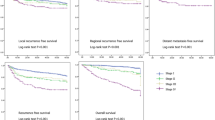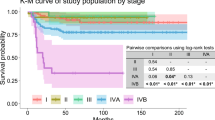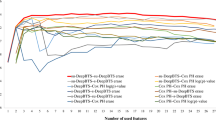Abstract
Objectives
To assess the performance of DeepSurv, a deep learning-based model in the survival prediction of laryngeal squamous cell carcinoma (LSCC) using the Surveillance, Epidemiology, and End Results (SEER) database.
Methods
In this large population-based study, we developed and validated a deep learning survival neural network using pathologically diagnosed patients with LSCC from the SEER database between January 2010 and December 2018. Totally 13 variables were included in this network, including patients baseline characteristics, stage, grade, site, tumor extension and treatment details. Based on the total risk score derived from this algorithm, a three-knot restricted cubic spline was plotted to exhibit the difference of survival benefits from two treatment modalities.
Results
Totally 6316 patients with LSCC were included in the study, of which 4237 cases diagnosed between 2010 and 2015 were selected as the development cohort, and the rest (2079 cases diagnosed from 2016 to 2018) were the validation cohort. A state-of-the-art deep learning-based model based on 23 features (i.e., 13 variables) was generated, which showed more superior performance in the prediction of overall survival (OS) than the tumor, node, and metastasis (TNM) staging system (C-index for DeepSurv vs TNM staging = 0.71; 95% CI 0.69–0.74 vs 0.61; 95% CI 0.60–0.63). Interestingly, a significantly nonlinear association between total risk score and treatment effectiveness was observed. When the total risk score ranges 0.1–1.5, surgical treatment brought more survival benefits than nonsurgical one for LSCC patients, especially in 70.5% of patients staged III–IV.
Conclusions
The deep learning-based model shows more potential benefits in survival estimation for patients with LSCC, which may potentially serve as an auxiliary approach to provide reliable treatment recommendations.


Similar content being viewed by others
References
Nocini R, Sanchis-Gomar F, Lippi G (2019) Physical activity and laryngeal cancer. Ann Transl Med 7(23):791
Zeng H, Huang Y, Chen L, Li H, Ma X (2020) Exploration and validation of the effects of robust co-expressed immune-related genes on immune infiltration patterns and prognosis in laryngeal cancer. Int Immunopharmacol 85:106622
Elicin O, Giger R (2020) Comparison of current surgical and non-surgical treatment strategies for early and locally advanced stage glottic laryngeal cancer and their outcome. Cancers (Basel) 12(3):732
Petersen JF, Stuiver MM, Timmermans AJ, Chen A, Zhang H, O’Neill JP, Deady S, Van der Poorten V, Meulemans J, Wennerberg J et al (2018) Development and external validation of a risk-prediction model to predict 5-year overall survival in advanced larynx cancer. Laryngoscope 128(5):1140–1145
Misono S, Marmor S, Yueh B, Virnig BA (2014) Treatment and survival in 10,429 patients with localized laryngeal cancer: a population-based analysis. Cancer 120(12):1810–1817
Edge SB, Compton CC (2010) The American Joint Committee on Cancer: the 7th edition of the AJCC cancer staging manual and the future of TNM. Ann Surg Oncol 17(6):1471–1474
Chen L, Lin G, Qian J, Chen Z, Wu X, Lin J, Chen Y, Chen Q, Zhuang Z, Hong Y et al (2021) A dynamic prognostic nomogram to predict the benefit from surgical treatment modality for patients with laryngeal squamous cell carcinoma. Head Neck 43(7):2148–2158
Bozec A, Culie D, Poissonnet G, Dassonville O (2020) Current role of total laryngectomy in the era of organ preservation. Cancers (Basel) 12(3):584
Lechien JR, Fakhry N, Saussez S, Chiesa-Estomba CM, Chekkoury-Idrissi Y, Cammaroto G, Melkane AE, Barillari MR, Crevier-Buchman L, Ayad T et al (2020) Surgical, clinical and functional outcomes of transoral robotic surgery for supraglottic laryngeal cancers: a systematic review. Oral Oncol 109:104848
Datema FR, Ferrier MB, Vergouwe Y, Moya A, Molenaar J, Piccirillo JF, Baatenburg de Jong RJ (2013) Update and external validation of a head and neck cancer prognostic model. Head Neck 35(9):1232–1237
Cui J, Wang L, Tan G, Chen W, He G, Huang H, Chen Z, Yang H, Chen J, Liu G (2020) Development and validation of nomograms to accurately predict risk of recurrence for patients with laryngeal squamous cell carcinoma: cohort study. Int J Surg 76:163–170
Chen L, Wang H, Zeng H, Zhang Y, Ma X (2020) Evaluation of CT-based radiomics signature and nomogram as prognostic markers in patients with laryngeal squamous cell carcinoma. Cancer Imaging 20(1):28
Katzman JL, Shaham U, Cloninger A, Bates J, Jiang T, Kluger Y (2018) DeepSurv: personalized treatment recommender system using a Cox proportional hazards deep neural network. BMC Med Res Methodol 18(1):24
She Y, Jin Z, Wu J, Deng J, Zhang L, Su H, Jiang G, Liu H, Xie D, Cao N et al (2020) Development and validation of a deep learning model for non-small cell lung cancer survival. JAMA Netw Open 3(6):e205842
Adeoye J, Hui L, Koohi-Moghadam M, Tan JY, Choi SW, Thomson P (2022) Comparison of time-to-event machine learning models in predicting oral cavity cancer prognosis. Int J Med Inform 157:104635
Byun SS, Heo TS, Choi JM, Jeong YS, Kim YS, Lee WK, Kim C (2021) Deep learning based prediction of prognosis in nonmetastatic clear cell renal cell carcinoma. Sci Rep 11(1):1242
Howard FM, Kochanny S, Koshy M, Spiotto M, Pearson AT (2020) Machine learning-guided adjuvant treatment of head and neck cancer. JAMA Netw Open 3(11):e2025881
El Sharouni MA, Ahmed T, Varey AHR, Elias SG, Witkamp AJ, Sigurdsson V, Suijkerbuijk KPM, van Diest PJ, Scolyer RA, van Gils CH et al (2021) Development and validation of nomograms to predict local, regional, and distant recurrence in patients with thin (T1) melanomas. J Clin Oncol 39(11):1243–1252
Yang HS, Li B, Liu SH, Ao M (2021) Nomogram model for predicting postoperative survival of patients with stage IB-IIA cervical cancer. Am J Cancer Res 11(11):5559–5570
Zheng X, Guo K, Wasan HS, Ruan S (2021) A population-based study: how to identify high-risk T1 gastric cancer patients? Am J Cancer Res 11(4):1463–1479
Gu J, Zuo Z, Sun L, Li L, Zhao N (2020) Prognostic factors for laryngeal sarcoma and nomogram development for prediction: a retrospective study based on SEER database. Ann Transl Med 8(8):545
Balachandran VP, Gonen M, Smith JJ, DeMatteo RP (2015) Nomograms in oncology: more than meets the eye. Lancet Oncol 16(4):e173–e180
Zhu X, Heng Y, Zhou L, Zhang M, Li W, Tao L (2020) Survival prediction and treatment strategies for patients with advanced laryngeal carcinoma: a population-based study. Int J Clin Oncol 25(8):1483–1491
Forastiere AA, Goepfert H, Maor M, Pajak TF, Weber R, Morrison W, Glisson B (2003) Concurrent chemotherapy and radiotherapy for organ preservation in advanced laryngeal cancer. N Engl J Med 349(22):2091–2098
Funding
This research was funded by the Non-profit Central Research Institute Fund of Chinese Academy of Medical Sciences under Grant 2017PT32013.
Author information
Authors and Affiliations
Corresponding author
Ethics declarations
Conflict of interest
None declared.
Additional information
Publisher's Note
Springer Nature remains neutral with regard to jurisdictional claims in published maps and institutional affiliations.
Rights and permissions
Springer Nature or its licensor holds exclusive rights to this article under a publishing agreement with the author(s) or other rightsholder(s); author self-archiving of the accepted manuscript version of this article is solely governed by the terms of such publishing agreement and applicable law.
About this article
Cite this article
Liao, F., Wang, W. & Wang, J. A deep learning-based model predicts survival for patients with laryngeal squamous cell carcinoma: a large population-based study. Eur Arch Otorhinolaryngol 280, 789–795 (2023). https://doi.org/10.1007/s00405-022-07627-w
Received:
Accepted:
Published:
Issue Date:
DOI: https://doi.org/10.1007/s00405-022-07627-w




